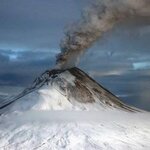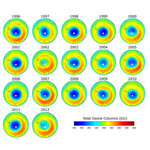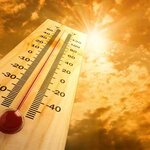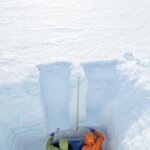Atmospheric

Why didn't the Earth warm as much as estimates and numerical models projected would happen between 2000 and 2010? A new paper says now thinks the culprits are hiding in plain sight; they are dozens of volcanoes spewing sulfur dioxide.
The key to the new results was the combined use of two computer models, including the Whole Atmosphere Community Climate Model, or WACCM, Version 3, developed by NCAR and which is widely used around the world by scientists to study the atmosphere. The group coupled WACCM with a second model, the Community Aerosol and Radiation Model for Atmosphere, or…

Climate change causing every weather event enjoyed the kind of fallacious media coverage in late 2012 it hadn't gotten since 2006 - it remains bad science. While short-term weather is notoriously volatile, climate is more of an average weather pattern over a long period of time. This dichotomy provides the analytical framework for scientific thinking about atmospheric variability, including climate change.
But even the weather-climate dichotomy paints an incomplete picture.one that may be complicating efforts to untangle natural variations in climate from man-made effects, according to a…

Donald Wuebbles, a professor of atmospheric sciences at the University of Illinois at Urbana-Champaign, is going to do the thing the IPCC wishes people would not do; attribute local weather events to climate change.
The hurricanes and droughts like we had in 2012 will be more frequent in future U.S. five-day forecasts, as will other extreme weather events, and it's because of human-driven climate change he argues today at the AAAS meeting in Boston. In the 1950s, the number of days that set record high temperatures was equal to the number of days that set record low temperatures. By the 2000s…

New satellite images show that the ozone hole over Antarctica in 2012 was the smallest seen in the past decade. Long-term observations show that Earth’s ozone has been strengthening. The ozone sensor on Europe’s MetOp weather satellite continues the long-term monitoring of atmospheric ozone started by its predecessors on the ERS-2 and Envisat satellites.
Since the beginning of the 1980s, an ozone hole has developed over Antarctica during the southern spring, September to November, resulting in a decrease in ozone concentration of up to 70%. Ozone depletion is more extreme in…

In the ongoing culture war among climate scientists, climate scientologists and climate deniers, few things stands out like the effect of volcanoes.
Volcanoes are well-known for cooling the climate but how much has been unclear, leading to radically differing claims and interpretations. Atmospheric chemists from the Tokyo Institute of Technology and the University of Copenhagen say that patterns of isotopes found in ancient volcanic sulfur trapped in ice cores, and patterns due to stratospheric photochemistry, are a way to say for sure which historic episodes of global cooling were…

Does naming every large storm something new and distinct help?
When all those media companies in midtown Manhattan wanted to put on their election push and remind America global warming would only happen if they voted for the wrong guy, they were disappointed that Hurricane Sandy was not actually a hurricane any more - so they called it Superstorm Sandy. It was good marketing.
A few days ago, I got an email from the Weather Channel outlining all of their coverage for winter storm Nemo and where they would have meteorologists, etc.
Nemo? I thought. When did we start naming every storm…

The upcoming century could see trees in the continental US producing spring leaves an average of 17 days earlier than in the past century, according to a new study by Princeton University researchers.
The good news: These changes could lead to changes in the composition of northeastern forests and give a boost to their ability to take up carbon dioxide.
Trees play an important role in taking up carbon dioxide from the atmosphere, so researchers wanted to evaluate predictions of spring budburst — when deciduous trees push out new growth after months of winter dormancy — from models that…

At least in America, CO2 emissions have dropped dramatically. The energy sector, the largest producer of CO2, is already back at early 1990s levels of emissions and the traditionally worst offender, coal, is at early 1980s levels.
CO2 is the primary greenhouse gas emitted by human activity. A simple way to measure climate sensitivity is to calculate how much the mean air temperature will rise if we were to double the level of overall CO2 emissions compared to the world's pre-industrialized level around the year 1750. If we continue to emit greenhouse gases at our current rate, estimates are…

For two decades, carbon dioxide was touted as the silver bullet for halting climate change. What about methane, what about NO2, and what about soot?
Soot, that black carbon that causes smoggy skies (and has sent Beijing's Pollution Index right off the charts) is the number two contributor to global warming, second to carbon dioxide, according to a four-year assessment by an international panel that is not the Intergovernmental Panel on Climate Change.
The new study concludes that black carbon, the soot particles in smoke and smog, contributes about twice as much to global…

Scientists have established that the majority of ozone-depleting iodine oxide observed over the remote ocean comes from a previously unknown marine source - the principal source of iodine oxide can be explained by emissions of hypoiodous acid (HOI), a gas not yet considered as being released from the ocean, along with a contribution from molecular iodine (I2).
Since the 1970s when methyl iodide (CH3I) was discovered as ubiquitous in the ocean, the presence of iodine in the atmosphere has been understood to arise mainly from emissions of organic compounds from phytoplankton -- microscopic…